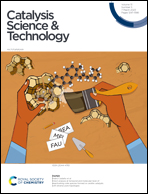High-efficiency, visible-light-induced direct dehydrogenative phosphonylation by bismuth quantum dots under ambient conditions†
Abstract
Organophosphorus compounds display excellent chemical and biological properties that the S–P(O) bonds afford utility in various fields. Herein, we report for the first time on the utilization of zero-dimensional (0D) monoelemental bismuth (Bi) quantum dots (QDs) as photocatalysts for direct dehydrogenative phosphonylation under visible light irradiation. A tiny amount of 0D Bi QDs (1.5 mol%) show high photocatalytic efficiency in the direct formation of S–P(O) between thiols and H–P(O) compounds under visible light with simple protocol, amenable gram-scale synthesis and good reusability. The mechanism study and density functional theory (DFT) calculation demonstrate the sulfide radial generated on the surface of 0D Bi QDs. The DFT study also indicates that the as-synthesized 0D Bi QDs exhibit suitable adsorption energy and sufficient charge transfer to effectively promote phosphonylation. We believe that such unique transformation can pave the way to more sustainable organic photocatalytic transformations based on high-efficiency QDs or QD-related nanocomposites.



 Please wait while we load your content...
Please wait while we load your content...